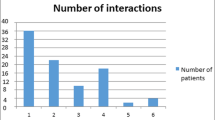Abstract
Of 5,125 mostly elderly out-patients, average age 78.2 years, 1,594 (31%) had at least one interacting drug combination according to the Swedish National Formulary. On average, each patient with drug-drug interactions (DDIs) had 1.6 DDIs. There was no difference in the sex or age between those having DDIs and those without. However, patients with one or more DDIs used a significantly larger number of drugs than those without DDIs, on average 8.1 versus 5.2. This significant difference was independent of age and sex. When classified for clinical significance according to the handbook “Drug Interactions and Updates” by Hansten and Horn, 155 (3%) patients had interactions of ‘major clinical significance’. The most common were interactions between Β-adrenergic blockers and antidiabetics, followed by potassium-sparing diuretics and potassium, and carbamazepine and dextropropoxyphene. The methodology allows us to screen routinely for DDIs and to plan further studies with emphasis on clinical outcome.
Similar content being viewed by others
References
FASS [Pharmaceutical specialities in Sweden]. Stockholm: LÄkemedelsinformation AB, 1993.
Prescott LF. Clinical important drug interactions. In: Speight TM, editor. Avery's drug treatment. Principles and practice of clinical pharmacology and therapeutics. Aukland: ADIS Press, 1987.
McInnes GT, Brodie MJ. Drug interactions that matter. A critical reappraisal. Drugs 1988;36:83–110.
Jankel CA, Speedie SM. Detecting drug interactions: a review of the literature. DICP 1990;24:982–9.
Jinks MJ, Hansten PD, Hirschman JL. Drug interaction exposures in an ambulatory medical population. Am J Hosp Pharm 1979;36:923–7.
Mitchell GW, Stanaszek WF, Nichols NB. Documenting drug-drug interactions in ambulatory patients. Am J Hosp Pharm 1979;36:653–9.
Gosney M, Tsallis R. Prescription of contraindicated and interacting drugs in elderly patients admitted to hospital. Lancet 1984;1:564–7.
Einarson TR. Drug-related hospital admissions. Ann Pharmacother 1993;27:832–40.
Hallas J, Gram LF, Grodum E, Damsbo N, Brosen K, Haghfelt T, et al. Drug related admissions to medical wards: a population based survey. Br J Clin Pharmacol 1992;33:61–8.
Jankel CA, Fitterman LK. Epidemiology of drug-drug interactions as a cause of hospital admissions. Drug Safety 1993;9:51–9.
Hagman M. Interaktioner vid receptexpedition [Interactions when handling the prescriptions]. Sv Farm Tidsskr 1991;95:23–5.
Markgren K, ögren J-E, Boman K, Allgulander S. LÄkemedelskonsumtionen på sjukhem och servicehus — en kartlÄggning i Skellefteå sjukvårdsdistrikt [Drug utilization at nursing homes and homes for the aged — a survey in the health care district of Skellefteå]. Sv Farm Tidsskr 1993;97:20–3.
Anatomical Therapeutic Chemical (ATC) classification index. Oslo: WHO Collaborating Centre for Drug Statistics Methodology, 1993.
Sjöqvist F. Interaktion mellan lÄkemedel [Drug-drug interactions]. In: FASS [Pharmaceutical specialities in Sweden]. Stockholm: LÄkemedelsinformation AB, 1993.
Hansten PD, Horn JR. Drug interactions and updates. 7th ed. Philadelphia: Lea & Febiger, 1990.
Cardieux RJ. Drug interactions in the elderly. How multiple drug use increases risk exponentially. Postgrad Med 1989;86:179–86.
D'Arcy PF. Drug reactions and interactions in the elderly patient. DICP 1982;16:925–9.
Kurfees JF, Dotson RL. Drug interactions in the elderly. J Fam Pract 1987;25:477–88.
Armstrong WA, Driever CW, Hays RL. Analysis of drug-drug interactions in a geriatric population. Am J Hosp Pharm 1980;37:385–7.
Deacon SP, Karunanayake A, Barnett D. Acebutolol, atenolol and propranolol and metabolic responses to acute hypoglycaemia in diabetics. BMJ 1977;2:1255–7.
Kerr D, MacDonald IA, Heller SR, Tattersall RB. Beta-adrenoceptor blockade and hypoglycaemia. A randomised, doubleblind, placebo-controlled comparison of metoprolol CR, atenolol and propranolol LA in normal subjects. Br J Clin Pharmacol 1990;29:685–93.
Newman RJ. Comparison of propranolol, metoprolol and acebutolol on insulin-induced hypoglycaemia. BMJ 1976;2:447–9.
Viberti GC, Keen H, Bloom SR. Beta blockade and diabetes mellitus: effect of oxprenolol and metoprolol on the metabolic, cardiovascular and hormonal response to insulin-induced hypoglycemia in insulin-dependent diabetics. Metabolism 1980;29:873–9.
Author information
Authors and Affiliations
Rights and permissions
About this article
Cite this article
Bergendal, L., Friberg, A. & Schaffrath, A. Potential drug-drug interactions in 5,125 mostly elderly out-patients in Gothenburg, Sweden. Pharm World Sci 17, 152–157 (1995). https://doi.org/10.1007/BF01879709
Accepted:
Issue Date:
DOI: https://doi.org/10.1007/BF01879709



